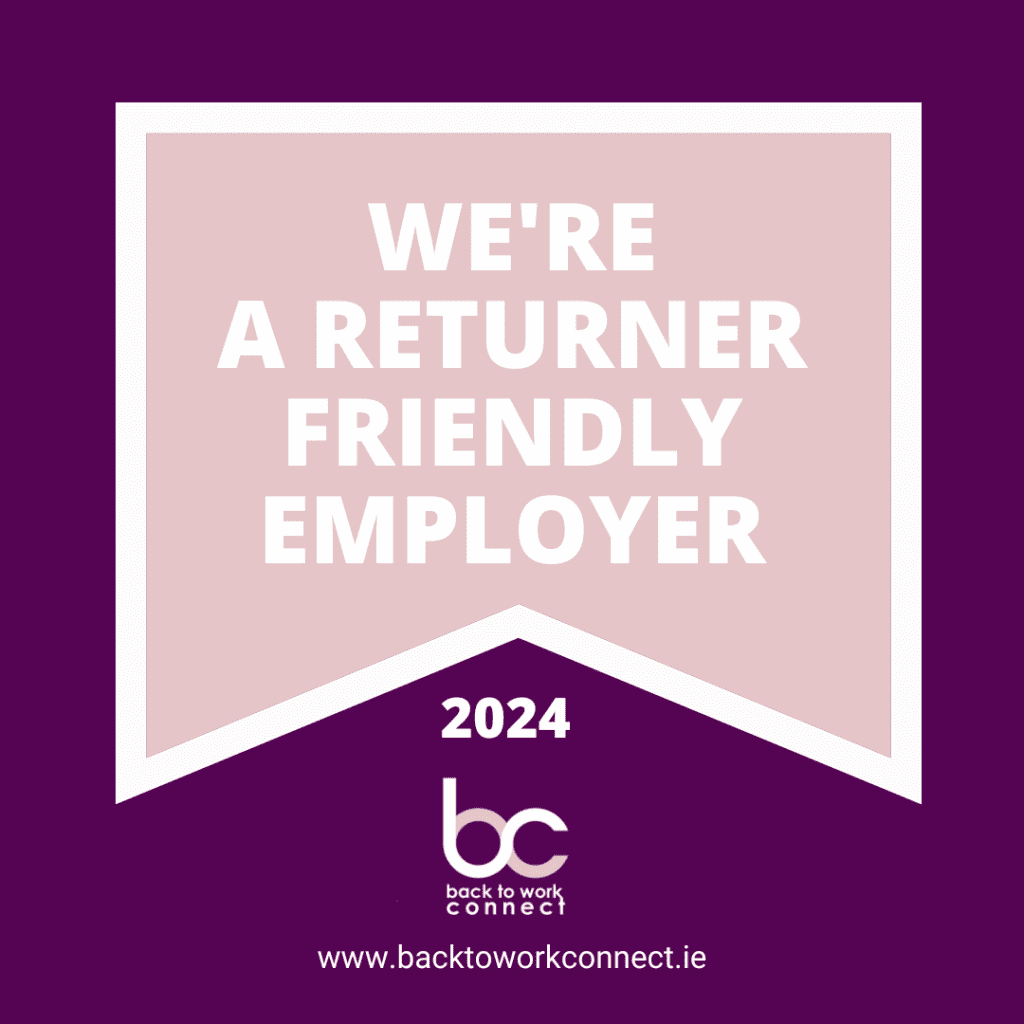Guide to Returner–Friendly Recruitment
But first, what (who) is a Returner?
This word has many meanings and is surrounded by stigma & misconceptions. But, when we look behind the word, we see a diverse group of midlife workers who are
- highly skilled
- motivated
- experienced
- ambitious and ultimately,
- eager to return to the workplace following a career gap.
Introducing returner-friendly hiring processes can help your organisations attract and retain skilled midlife workers who are looking to re-enter the workforce after a career break.
Here are some strategies that can help;
Step 1: Develop Dedicated Returner Programs
Step 2: Inclusive Job Descriptions
Step 3: Interview Techniques
Step 4: Offer Flexible Working Arrangements
Step 5: Onboarding and Training
Step 6: Mentorship, Networking & Support
Step 7: Feedback
Step 8: Awareness and Training for Staff
Step 9: Partnerships with External Organisations like Back To Work Connect
Step 1: Develop Dedicated Returner Programs
Consider offering structured internships or short-term projects that allow returners to refresh their skills and demonstrate their abilities.
Step 2: Inclusive Job Descriptions
Focus on essential skills and competencies rather than continuous work experience. Highlight transferable skills that are valuable irrespective of a career break.
Use language that encourages returners to apply, avoiding terms like “recent experience” or “current role.”
Encouraging midlife workers to return to work after a career break requires language that is supportive, inclusive, and empowering.
Use Returner Friendly phrases including
Opportunity: Highlight the return to work as an opportunity for personal and professional growth.
Support: Assure them of support systems in place to help ease the transition back to the workforce.
Flexibility: Emphasis the flexibility of the work environment to accommodate their needs.
Skills: Recognise and value the skills they bring, gained from both their previous work experience and time away.
Balance: Stress the importance of work-life balance and how the workplace accommodates it.
Community: Emphasise the sense of belonging and community within the workplace.
Progression: Highlight opportunities for career progression and advancement.
Impact: Illustrate how their return to work can make a positive impact, both personally and professionally.
Confidence: Encourage them to have confidence in their abilities and the value they bring to the workplace.
Step 3: Interview Techniques
Train interviewers to ask questions that focus on skills and competencies rather than chronological work history. Consider offering preliminary informational interviews or skills assessments.
Normalise career breaks by explicitly stating that gaps in employment history are understood and accepted.
Step 4: Flexible Working Arrangements
Offer part-time, flexible working hours, or job-sharing arrangements to help returners manage their transition back into the workforce.
Provide options for remote or hybrid working to accommodate personal commitments and reduce the stress of commuting.
Step 5: Onboarding and Training
Provide comprehensive onboarding and tailored training programs to help returners update their industry knowledge and skills such as Back To Work Connect’s Finding Your Feet*
Step 6: Mentorship, Networking & Support
Pair returners with mentors who can provide guidance, support, and advice as they reintegrate into the workforce.
Create opportunities for returners to connect with colleagues and industry peers through networking events and professional associations.
Establish peer support groups where returners can share experiences, challenges, and solutions.
Provide access to services such as counselling, coaching, and career advice to support returners’ transition.
Step 7: Feedback
Solicit feedback from returners on their onboarding and integration experiences to continuously improve the process.
Monitor the performance and career progression of returners to ensure they have equal opportunities for advancement.
Step 8: Awareness and Training for Staff
Offer training for all employees to foster an inclusive and supportive environment for returners.
Highlight success stories of returners within the organization to inspire confidence and demonstrate the company’s commitment.
Step 9: Partnerships with External Organisations like Back To Work Connect
Introduce the Returner Friendly Badge

The Returner Friendly badge sends a powerful message to existing and potential employees that you are an inclusive employer, open to promoting and encouraging gender & age diversity in your workplace.
By implementing these strategies, your organisations can create a more inclusive and supportive hiring process that not only attracts returners but also leverages their valuable skills and experiences.
If you would like to hear more about creating Returner Friendly recruitment policies you can contact our team at info@backtoworkconnect.ie





